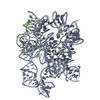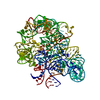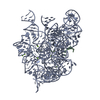[English] 日本語
 Yorodumi
Yorodumi- PDB-7r6m: Post-2S intermediate of the Tetrahymena group I intron, symmetry-... -
+ Open data
Open data
- Basic information
Basic information
| Entry | Database: PDB / ID: 7r6m | ||||||||||||||||||
|---|---|---|---|---|---|---|---|---|---|---|---|---|---|---|---|---|---|---|---|
| Title | Post-2S intermediate of the Tetrahymena group I intron, symmetry-expanded monomer from a synthetic dimeric construct | ||||||||||||||||||
 Components Components |
| ||||||||||||||||||
 Keywords Keywords |  RNA / RNA /  Ribozyme / Ribozyme /  Group I intron / Group I intron /  catalytic RNA catalytic RNA | ||||||||||||||||||
| Function / homology |  : / DNA/RNA hybrid / DNA/RNA hybrid (> 10) / : / DNA/RNA hybrid / DNA/RNA hybrid (> 10) /  RNA / RNA (> 10) / RNA (> 100) RNA / RNA (> 10) / RNA (> 100) Function and homology information Function and homology information | ||||||||||||||||||
| Biological species |   Tetrahymena thermophila (eukaryote) Tetrahymena thermophila (eukaryote) | ||||||||||||||||||
| Method |  ELECTRON MICROSCOPY / ELECTRON MICROSCOPY /  single particle reconstruction / single particle reconstruction /  cryo EM / Resolution: 3.68 Å cryo EM / Resolution: 3.68 Å | ||||||||||||||||||
 Authors Authors | Thelot, F. / Liu, D. / Liao, M. / Yin, P. | ||||||||||||||||||
| Funding support |  United States, 5items United States, 5items
| ||||||||||||||||||
 Citation Citation |  Journal: Nat Methods / Year: 2022 Journal: Nat Methods / Year: 2022Title: Sub-3-Å cryo-EM structure of RNA enabled by engineered homomeric self-assembly. Authors: Di Liu / François A Thélot / Joseph A Piccirilli / Maofu Liao / Peng Yin /  Abstract: High-resolution structural studies are essential for understanding the folding and function of diverse RNAs. Herein, we present a nanoarchitectural engineering strategy for efficient structural ...High-resolution structural studies are essential for understanding the folding and function of diverse RNAs. Herein, we present a nanoarchitectural engineering strategy for efficient structural determination of RNA-only structures using single-particle cryogenic electron microscopy (cryo-EM). This strategy-ROCK (RNA oligomerization-enabled cryo-EM via installing kissing loops)-involves installing kissing-loop sequences onto the functionally nonessential stems of RNAs for homomeric self-assembly into closed rings with multiplied molecular weights and mitigated structural flexibility. ROCK enables cryo-EM reconstruction of the Tetrahymena group I intron at 2.98-Å resolution overall (2.85 Å for the core), allowing de novo model building of the complete RNA, including the previously unknown peripheral domains. ROCK is further applied to two smaller RNAs-the Azoarcus group I intron and the FMN riboswitch, revealing the conformational change of the former and the bound ligand in the latter. ROCK holds promise to greatly facilitate the use of cryo-EM in RNA structural studies. | ||||||||||||||||||
| History |
|
- Structure visualization
Structure visualization
| Structure viewer | Molecule:  Molmil Molmil Jmol/JSmol Jmol/JSmol |
|---|
- Downloads & links
Downloads & links
- Download
Download
| PDBx/mmCIF format |  7r6m.cif.gz 7r6m.cif.gz | 180.6 KB | Display |  PDBx/mmCIF format PDBx/mmCIF format |
|---|---|---|---|---|
| PDB format |  pdb7r6m.ent.gz pdb7r6m.ent.gz | 135.9 KB | Display |  PDB format PDB format |
| PDBx/mmJSON format |  7r6m.json.gz 7r6m.json.gz | Tree view |  PDBx/mmJSON format PDBx/mmJSON format | |
| Others |  Other downloads Other downloads |
-Validation report
| Arichive directory |  https://data.pdbj.org/pub/pdb/validation_reports/r6/7r6m https://data.pdbj.org/pub/pdb/validation_reports/r6/7r6m ftp://data.pdbj.org/pub/pdb/validation_reports/r6/7r6m ftp://data.pdbj.org/pub/pdb/validation_reports/r6/7r6m | HTTPS FTP |
|---|
-Related structure data
| Related structure data |  24282MC  7r6lC  7r6nC M: map data used to model this data C: citing same article ( |
|---|---|
| Similar structure data | Similarity search - Function & homology  F&H Search F&H Search |
- Links
Links
- Assembly
Assembly
| Deposited unit | 
|
|---|---|
| 1 |
|
- Components
Components
| #1: RNA chain |  Group I catalytic intron Group I catalytic intronMass: 128011.562 Da / Num. of mol.: 1 / Source method: obtained synthetically / Source: (synth.)   Tetrahymena thermophila (eukaryote) / References: Tetrahymena thermophila (eukaryote) / References:  GenBank: V01416 GenBank: V01416 | ||
|---|---|---|---|
| #2: DNA/RNA hybrid | Mass: 4356.657 Da / Num. of mol.: 1 / Source method: obtained synthetically / Source: (synth.)   Tetrahymena thermophila (eukaryote) Tetrahymena thermophila (eukaryote) | ||
| #3: Chemical | ChemComp-MG / Has ligand of interest | Y | |
-Experimental details
-Experiment
| Experiment | Method:  ELECTRON MICROSCOPY ELECTRON MICROSCOPY |
|---|---|
| EM experiment | Aggregation state: PARTICLE / 3D reconstruction method:  single particle reconstruction single particle reconstruction |
- Sample preparation
Sample preparation
| Component | Name: Post-2S intermediate of Tetrahymena group I intron, symmetry-expanded monomer from a synthetic dimeric construct Type: COMPLEX / Entity ID: #1-#2 / Source: SYNTHETIC | |||||||||||||||
|---|---|---|---|---|---|---|---|---|---|---|---|---|---|---|---|---|
| Molecular weight | Value: 0.13 MDa / Experimental value: NO | |||||||||||||||
| Source (natural) | Organism:   Tetrahymena thermophila (eukaryote) Tetrahymena thermophila (eukaryote) | |||||||||||||||
| Buffer solution | pH: 8 | |||||||||||||||
| Buffer component |
| |||||||||||||||
| Specimen | Conc.: 1 mg/ml / Embedding applied: NO / Shadowing applied: NO / Staining applied : NO / Vitrification applied : NO / Vitrification applied : YES : YES | |||||||||||||||
| Specimen support | Grid material: COPPER / Grid mesh size: 400 divisions/in. / Grid type: Quantifoil R1.2/1.3 | |||||||||||||||
Vitrification | Instrument: FEI VITROBOT MARK IV / Cryogen name: ETHANE / Humidity: 100 % / Chamber temperature: 277 K |
- Electron microscopy imaging
Electron microscopy imaging
| Experimental equipment |  Model: Titan Krios / Image courtesy: FEI Company |
|---|---|
| Microscopy | Model: FEI TITAN KRIOS |
| Electron gun | Electron source : :  FIELD EMISSION GUN / Accelerating voltage: 300 kV / Illumination mode: OTHER FIELD EMISSION GUN / Accelerating voltage: 300 kV / Illumination mode: OTHER |
| Electron lens | Mode: OTHER / Nominal magnification: 105000 X / Cs : 2.7 mm : 2.7 mm |
| Image recording | Electron dose: 47 e/Å2 / Film or detector model: GATAN K3 (6k x 4k) |
- Processing
Processing
CTF correction | Type: PHASE FLIPPING AND AMPLITUDE CORRECTION |
|---|---|
3D reconstruction | Resolution: 3.68 Å / Resolution method: FSC 0.143 CUT-OFF / Num. of particles: 113548 / Symmetry type: POINT |
 Movie
Movie Controller
Controller






 PDBj
PDBj































